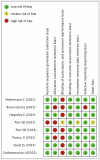Time-Restricted Eating Improves Glycemic Control in Patients with Type 2 Diabetes: A Meta-Analysis and Systematic Review
- PMID: 40806442
- PMCID: PMC12346854
- DOI: 10.3390/ijms26157310
Time-Restricted Eating Improves Glycemic Control in Patients with Type 2 Diabetes: A Meta-Analysis and Systematic Review
Abstract
Time-restricted eating (TRE), a dietary strategy that aligns food intake with circadian rhythms, has emerged as a promising non-pharmacological approach for improving glycemic control in patients with type 2 diabetes. This systematic review and meta-analysis evaluated the effects of TRE on glycemic outcomes by analyzing eight randomized controlled trials involving 312 participants with type 2 diabetes or impaired fasting glucose. Meta-analyses of six eligible studies demonstrated that TRE significantly reduced fasting glucose (mean difference [MD]: -0.74 mmol/L; 95% CI: -1.13 to -0.36) and glycated hemoglobin (ΔHbA1c) (MD: -0.11%; 95% CI: -0.15 to -0.07) and increased time in range (TIR) for blood glucose (MD: +10.51%; 95% CI: 6.81 to 14.21). Improvements in fasting glucose and HbA1c were modest but consistent, while the increase in TIR showed no between-study heterogeneity, suggesting a robust and reproducible benefit of TRE on glycemic stability. These findings support the clinical feasibility and effectiveness of TRE as a dietary intervention in diabetes management. However, further high-quality trials with standardized protocols and longer follow-up are needed to confirm long-term efficacy and inform guidelines.
Keywords: HbA1c; diabetes mellitus; fasting glucose; glycemic control; meta-analysis; time in range; time-restricted eating.
Conflict of interest statement
The authors declare no conflicts of interest.
Figures





Similar articles
-
Hybrid closed-loop systems for managing blood glucose levels in type 1 diabetes: a systematic review and economic modelling.Health Technol Assess. 2024 Dec;28(80):1-190. doi: 10.3310/JYPL3536. Health Technol Assess. 2024. PMID: 39673446 Free PMC article.
-
Circadian alignment of food intake and glycaemic control by time-restricted eating: A systematic review and meta-analysis.Rev Endocr Metab Disord. 2024 Apr;25(2):325-337. doi: 10.1007/s11154-023-09853-x. Epub 2023 Nov 22. Rev Endocr Metab Disord. 2024. PMID: 37993559 Free PMC article.
-
Glucose-lowering agents for treating pre-existing and new-onset diabetes in kidney transplant recipients.Cochrane Database Syst Rev. 2017 Feb 27;2(2):CD009966. doi: 10.1002/14651858.CD009966.pub2. Cochrane Database Syst Rev. 2017. Update in: Cochrane Database Syst Rev. 2020 Jul 30;8:CD009966. doi: 10.1002/14651858.CD009966.pub3. PMID: 28238223 Free PMC article. Updated.
-
The impact of intermittent fasting on body composition and cardiometabolic outcomes in overweight and obese adults: a systematic review and meta-analysis of randomized controlled trials.Nutr J. 2025 Jul 30;24(1):120. doi: 10.1186/s12937-025-01178-6. Nutr J. 2025. PMID: 40731344 Free PMC article. Review.
-
The Effect of Dietary Glycaemic Index on Glycaemia in Patients with Type 2 Diabetes: A Systematic Review and Meta-Analysis of Randomized Controlled Trials.Nutrients. 2018 Mar 19;10(3):373. doi: 10.3390/nu10030373. Nutrients. 2018. PMID: 29562676 Free PMC article.
References
-
- Banerjee M., Khursheed R., Yadav A.K., Singh S.K., Gulati M., Pandey D.K., Prabhakar P.K., Kumar R., Porwal O., Awasthi A., et al. A Systematic Review on Synthetic Drugs and Phytopharmaceuticals Used to Manage Diabetes. Curr. Diabetes Rev. 2020;16:340–356. doi: 10.2174/1573399815666190822165141. - DOI - PubMed
Publication types
Grants and funding
LinkOut - more resources
Full Text Sources

